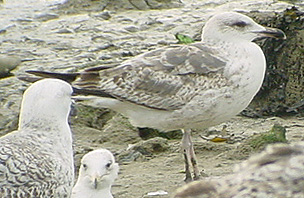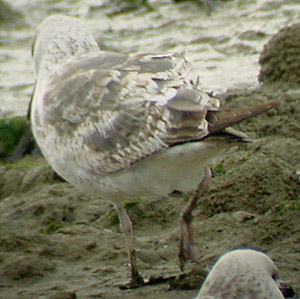 Photo 9: LBBG, May
04 2001, Le Portel
(France).
Photo 9: LBBG, May
04 2001, Le Portel
(France).  Photo 9: LBBG, May
04 2001, Le Portel
(France).
Photo 9: LBBG, May
04 2001, Le Portel
(France).
A second type LBBG in first winter with a few
third generation grey scapulars and moulting the
median coverts. Compared to michahellis at Le Portel, the grey tone is
much darker and actually well in line with intermedius LBBGs.
The inner median coverts (80%) are fresh second generation and moult is still in
progress. The inner greater covert is second generation as well, #2 is growing and already
visible in the right wing.
As can be seen in the left wing, tertial #1 is 2second generation and tertial #2 is
growing. The tail is still juvenile.
In the scapulars, all juvenile feathers were shed and grey new feathers may even
be of third generation, although they also might be late required second generation scapulars. In
LBBG it seems the scapulars moulted most recently in spring are much more
adult-like than the ones moulted before winter.
In most cases, when juvenile scapulars are still
present, it seems most reasonable to call greyish scapulars adult-like second generation, since an efficient strategy will first moult the older juvenile
feathers (successively replaced by second generation feathers). Here, no juvenile
scapulars
are found and the present second generation scapulars seem already pretty abraded, so the grey
feathers are likely to be third generation.
Compared to michahellis, moult strategy overlaps, and would fit both.
Clues to distinguish LBBG are dark inner primaries, a broad tail-band and the
dark grey-tone of the
scapulars.
